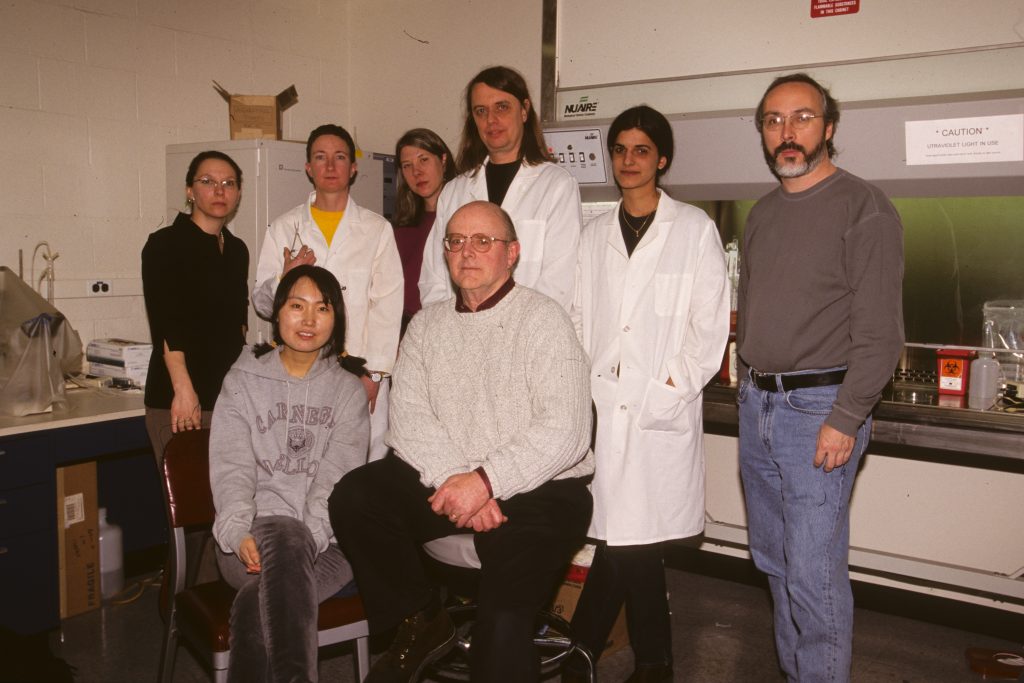Performed at the Natural History Museum, London; Gallery Oldham, Manchester; St. Norbert Art & Cultural Center, Winnipeg, and Le Magasin, Centre National d’Art Contemporain, Grenoble. GenTerra was a live exploration of the variety of discourses on transgenics in relation to environmental risk and human health policy. Participants manipulated transgenic bacteria in an effort to develop a more nuanced understanding of risk assessment regarding the uses of recombinant DNA.
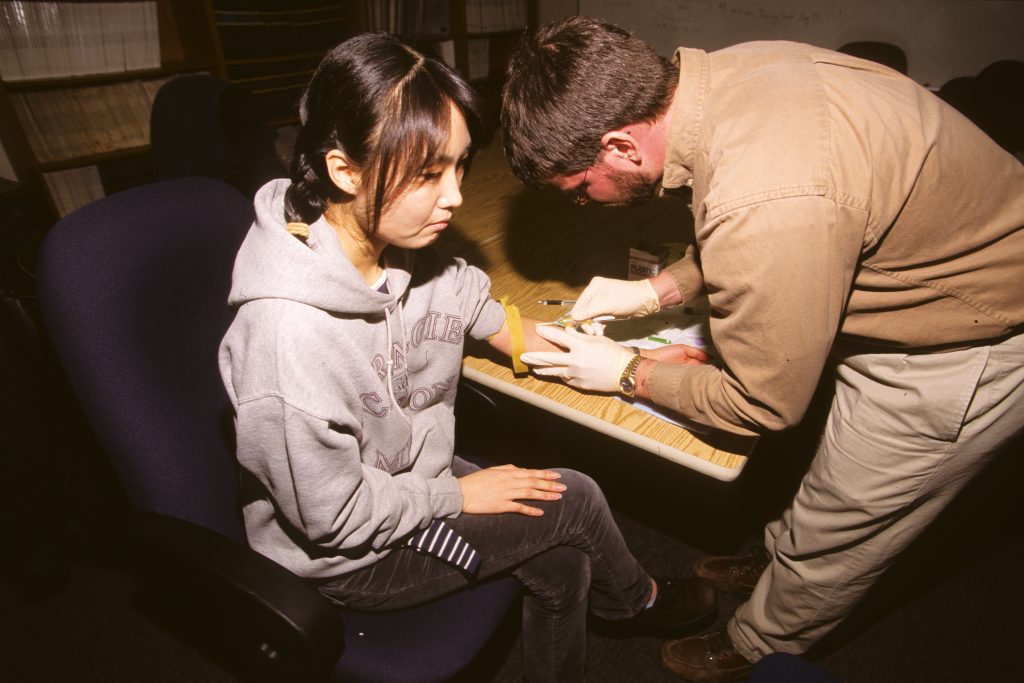
University of Pittsburgh, 2001 Blood samples are taken as a source of human DNA used in the creation of new forms of bacteria.
Fear and Profit in the Fourth Domain
One symbolic, dual directional, vertical flow that continuously proves fruitful in the examination of cultural structures and dynamics is the continuum between purity and pollution. The social organization of normative conditions tends to place purity at the top of the cultural value hierarchy, while pollution tends to lie at the bottom. There is no cross-cultural consistency in expressions of this separation in terms of belief, behavior, and representation, and within each culture, there are always contradictions and exceptions to the rules. To be sure, the endless negotiation of how to navigate through and organize the perceived manifestations of purity and pollution is a primary part of cultural becoming, and in many ways is key to describing and understanding cultural difference.
In western cultures, centuries of intense cultural exchange among the nations of Europe and North America have given rise to fundamental metanarratives that channel the expression of the categories of purity and pollution. Two fundamental and often linked metanarratives are God and Nature, which are charged with symbolically managing thoughts, behaviors, representations, and all other forms of expression by associating with them various degrees of value, legitimacy, and acceptability. Purity is a positive subcategory of these primary codes, and hence purity is associated with signs of goodness, legitimacy, and the authoritative. However, human agents are not only discouraged from fully realizing the category of purity on an earthly plane; they are forbidden from doing so. This quality is transcendent and beyond the capacity of humans. Anyone who claims purity (to be without sin or sickness, for example) will be punished by being classified and treated as a hypocrite, a criminal, a heretic, a schizophrenic, etc. Individuals instead are supposed to attempt to approximate the ideological phantasm of purity as best they can. However, even this expectation cannot exist in an unblemished form without endangering a given social constellation and the individuals within it. At times, pollution may or must be embraced. For example, if we accept the Freudian thesis that cleanliness (freedom from pollution) is a necessary part of civilization and associated with purity, it could be said that the accepted presentation of an individual covered in sand while at the beach is a retro-norm. Or, when a cancer patient must endure chemotherapy, thus allowing impurities to enter the body, this form of pollution is socially accepted and even encouraged, when it is medically authorized.

St. Norbert Art & Cultural Center, Winnipeg, 2001 GenTerra technician in dialogue with participants about issues regarding transgenic production and distribution.
Even though the purity/pollution polarity is one of imperfection and approximation, there are elements of the profane, the unclean, and the polluted that are strictly taboo. One of these general elements is the mixing of “natural” separations. Not only is such mixing not tolerated (unless it is due to the intervention of entities and/or forces outside of and in some way superior to humans), it has traditionally not even been believed possible. For example, in a crude system of classification, such as animal, vegetable, and fungi, normative standards deny that these fundamental elements may be mixed. Historically speaking, these are categories of purity of form that are transcendent. To mix them would be a crime against God and/or Nature. The problem now is that what was once thought to be impossible in terms of hybridity (the mixing of animal and plant for example) is now an actuality. Transgenic practices have thrown understanding of the natural order into an unresolved, contradictory rift, thus giving rise to a whole series of new questions about which authority may designate exceptions to the codes of organic purity. At present, there is no stable authority in regard to this matter, and hence a profound sense of ideological dissonance now haunts the western world.

St. Norbert Art & Cultural Center, Winnipeg, 2001 Participant decides whether or not to activate trangenic bacteria release machine.
The Fourth Domain
If popular, yet significant biological classification systems, such as animal and vegetable, are forgotten for the moment, and one instead examines the classifications used by specialists in biology, we find a general system of three domains.1[SK1] This scheme is relatively new and is based in molecular studies that reveal the existence of a small group of organisms now known as archaebacteria. Formerly, these organisms were placed in the kingdom Monera (a classification reserved solely for bacteria), because they appeared to be just another form of bacteria. However, since it has been recently discovered that these organisms have significant differences from bacteria in the composition of their 16s rRNA sequences, cell walls, plasma membranes, and other key molecular features, many scientists now believe that they should have their own unique classification. Furthermore, in terms of evolutionary distance from bacteria and eukaryotes, archaebacteria seem to require a domain of their own.2 Some biologists believe that the traditional general classification system of the five kingdoms (which is primarily based on morphology) is no longer suitable, given recent developments in molecular biology, and they now favor the domain classification system. Following this trend, and for the purposes of this essay, CAE will also use the domain system: bacteria are in the domain Bacteria; archaebacteria are in the domain Archaea; and eukaryotes are in the domain Eukarya.

St. Norbert Art & Cultural Center, Winnipeg, 2001 Participant prepares transgenic bacteria sample for her own use.
However, since DNA from these domains is now transversal, given new breakthroughs in transgenic practices, it seems that the time is right to suggest the creation of a fourth domain (Transgeneae). This domain would be reserved for organisms that were manufactured by mixing genomes (or parts thereof) from the three domains, in a manner different from species emergence through evolutionary process. Whether mixing genomic elements from the various domains (along with mixing genomic elements from different species of the same domain) will have the effect of creating creatures with significant enough differences to warrant such a radical classification is open to speculation.3 However, if molecular difference and evolutionary distance can give rise to such considerations, it would seem that radical intervention into the evolutionary process (both in terms of selection and velocity) and into genomic construction could make such a reclassification necessary. It should also be noted that classification systems are in a constant state of flux because of the rapid leaps in knowledge that various biological specializations are making on a regular and immediate basis. What at first might seem premature can quickly become necessary.

Darwin Centre, Museum of Natural History, London, 2003 Participants gather information about genetically modified organisms on the GenTerra website.
In the end, however, CAE is more than willing to leave biological classification systems to the specialists. At the same time, however, scientists must realize that no semiotic system is pure. Even scientific systems are affected by the recombinant nature of language. Social, political, and economic meanings all inform any textual configuration. While the fourth domain, from the point of view of the specialized position of molecular biology, may currently fall somewhere between the nonsensical and the speculative at best, it still represents a significant series of social, political, and economic separations. The appearance of organisms conceived within an ideological matrix of categorical mixing, and removed from the evolutionary chain via the process of manufacture, will have profound effects on biological sign and exchange value, will alter the construction of western cosmologies, and will dramatically affect the development of industries of applied biology and the general technological apparatus of all fields of communication and research. Perhaps the fourth domain will only function as a socio-political interpretive model, but even if this turns out to be the case, it will be compelling nonetheless.
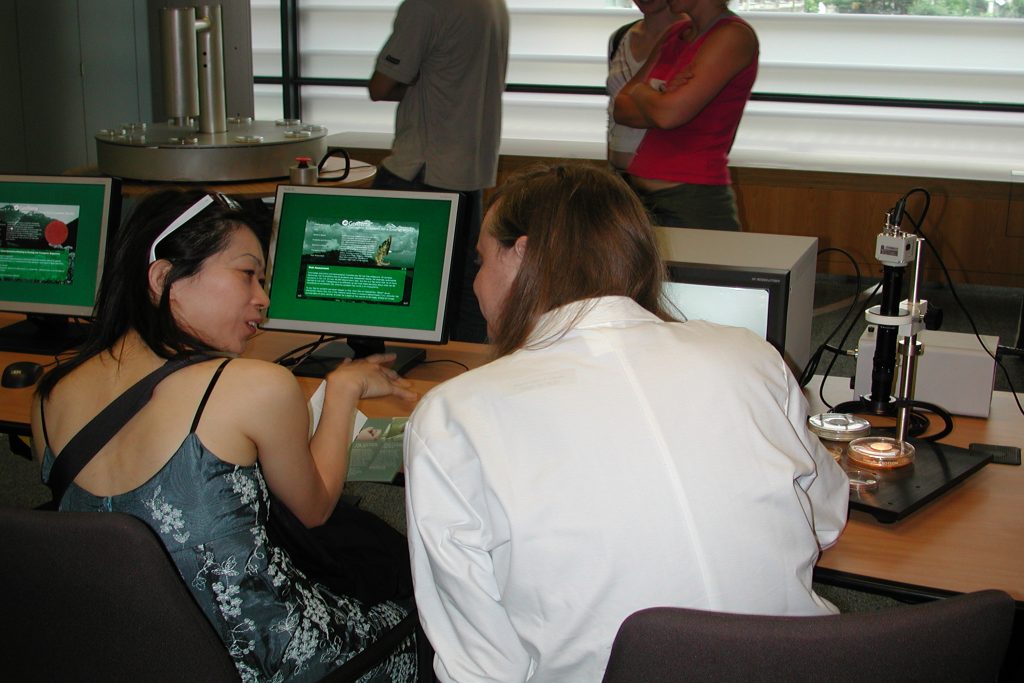
Darwin Centre, Museum of Natural History, London, 2003 GenTerra technician and participants in dialogue about issues regarding transgenic production and distribution.
The Mythology of the Fourth Domain
While the material appearance of the fourth domain has coincided with giddy euphoria among many biological specialists, industry leaders, and those willing to swiftly embrace new scientific and technological developments, its traditional mythic place has not been one of such positive associations. This domain was among the unnamable, either in its purity as the domain of the power of God(s), or in its profanity as unthinkable taboo in the realm of humans. This latter possibility is what defined its tendency for people in the west, thus establishing it as one key site associated with the ideology of fear. The fourth domain was the category of the monstrous: A location where mixing categories by humans conjured the sinful, the perverse, and the horrific, and thus offended God and/or Nature. For those who were willing to do what ought not be done, punishment was swift and harsh, coming from both secular and metaphysical forces. Entering the fourth domain was the ultimate challenge to the authority of order and all its institutional manifestations.
One need only look back to foundational mythic texts (in the broadest sense of the term) of the western world to see that hybridity was a concept stratified in accordance with social relations. A central text for issues of transformation, synthesis, and recombination is Ovid’s Metamorphoses. This work is a full compendium of becomings that reveal the rules of who has the power and ability to rearrange the natural order, and explains the consequences of such arrangements. Ovid offers two key rules about interventions in the natural order. The first is that creation, invention, and movement beyond the flow of the logos is limited to the will of the gods. The second is that such activity among humans (when not guided by the hands of the gods) will end in disaster. Punishment for such transgressions is contained within the process of recombination. Appropriating the power of the gods (whether manifesting as either a spiritual entity or as a natural force) will only speed a mortal’s confrontation with death-the harshest penalty is always issued for such excessive appropriations and is quickly delivered without remorse or pity.
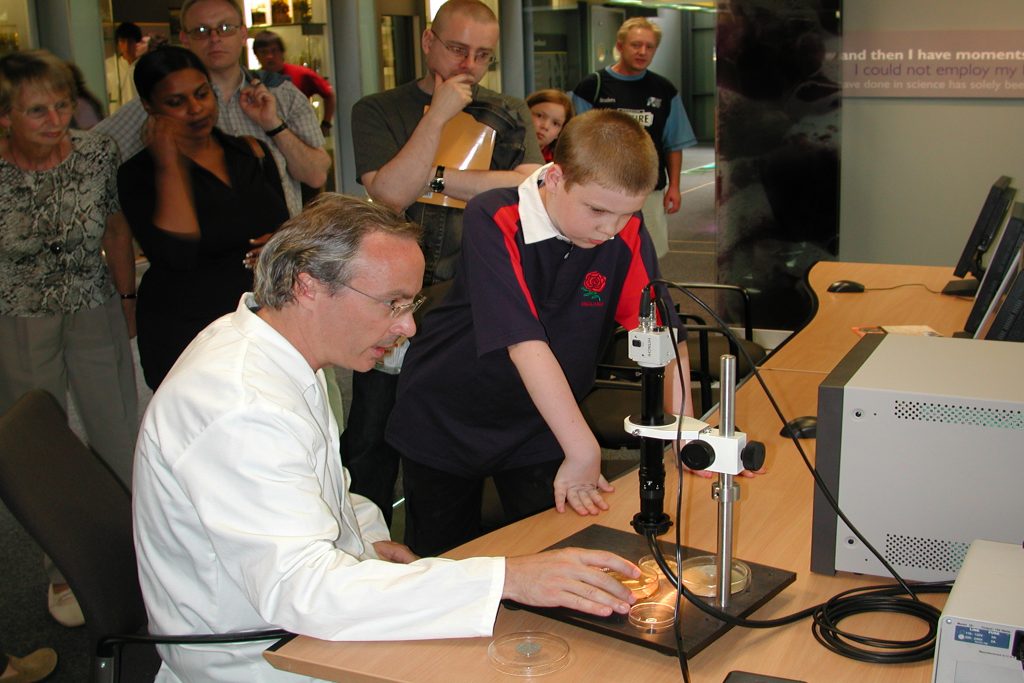
Darwin Centre, Museum of Natural History, London, 2003 Participant compares bacteria samples using a video microscope.
Let us examine a myth that illustrates each of the two principles. One less well-known myth is the story of Achelous and Peremele. Achelous (a river deity) tells this story to Theseus and some other honorable warriors while they wait for a river flood to subside. Achelous explains how he fell in love with and seduced the daughter (Peremele) of a local king. When the king discovered his daughter’s indiscretion, he concluded that the proper punishment was death, and tossed her off a cliff into the ocean. Achelous prayed to Neptune for aid; his prayer was heard, and Peremele was transformed into an island as a means to raise her above the sea. The separations regarding certain types of commingling are readily apparent. Peremele, from the human perspective, is perceived as radically transgressive for mixing her mortality with immortality. As usual, the punishment for engaging in this process is death. However, this is not what this myth emphasizes. That lesson, while consistent with the general text, is of secondary value. The primary lesson is that the gods have the power and the right to make any alteration in the natural order that they think is necessary, and it is only when they do it that there can be a positive outcome. This is not to say that there will always be a positive outcome. Conflicts among the gods (most notably Jove and Juno) can lead to monstrous outcomes. Even in a sacred sphere, recombination can take less than desirable turns. Polyphemus the cyclops or Io the heifer are such examples of the many monsters or unfortunate victims that populate this mythic landscape.
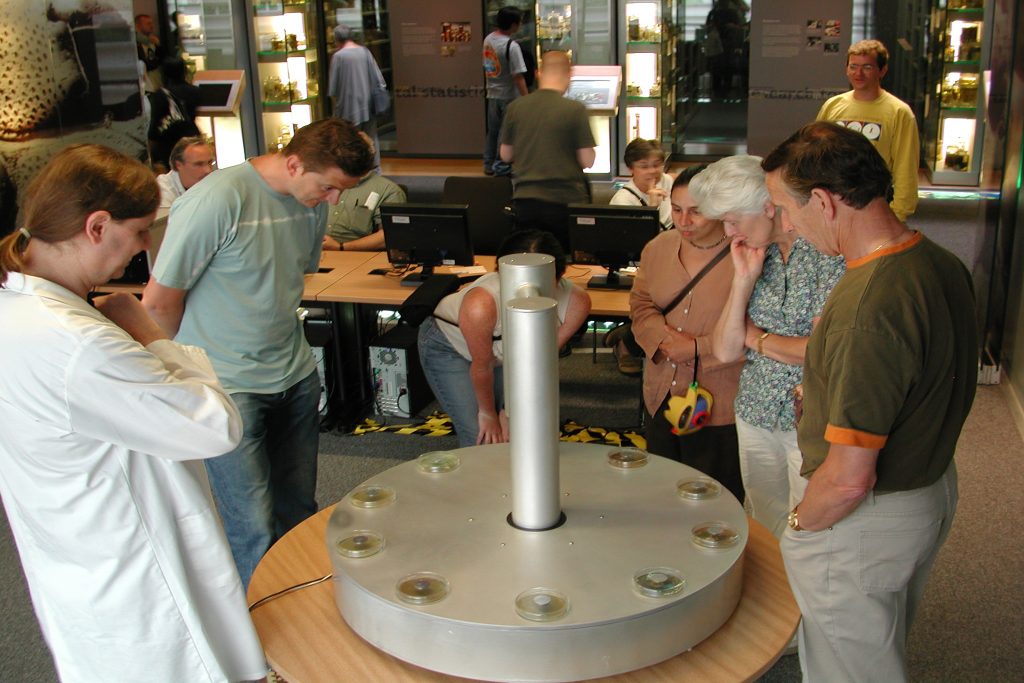
Darwin Centre, Museum of Natural History, London, 2003 This group of participants decide to activate the bacteria release machine.
The myth becomes even more compelling when Pirithous, one of the honorable warriors, challenges the story saying:
These are fairy tales;
The gods have no such powers, Achelous,
To give and take away the shapes of things.
The soldiers hearing this challenge are horrified, and the wise elder Lelex replies:
The power of Heaven has no bound or limit.
Whatever the gods will is done, believe it.
Lelex represents a consensus among heroes concerning the natural order. While there are spheres, even incredible spheres, open to heroic humans, there is still another one beyond human control that must be left to transcendental forces. This is the realm of creation and recombination.
A better known myth in Ovid’s volume is the story of Daedalus and Icarus. Held prisoner on Crete, Daedalus bemoans his fate and his inability to escape by sea routes that are well controlled by Cretan forces. However, he notices that the heavens are an open field that is not under the control of any king. He then devises a scheme to create wings that would allow him and his son to fly off the island and back to their homeland. He successfully transforms himself into a recombinant creature by appropriating some of the forms of a bird. Daedalus and his son fly from the island; however, Icarus, being young and impetuous, does not follow his father’s advice of staying the middle course (a quick lesson in Aristotelian ethics), and pushes the limits of his recombinatory nature by flying too high. The wax that holds the feathers in his wings melts due to the heat of the sun, releasing the feathers into the air, and Icarus falls from the sky, landing in the ocean where he drowns.
This myth focuses on what occurs when humans attempt to appropriate the space and skills of the gods. Rearranging the natural order is a “fatal art” that ends in accursed consequences. (Eventually such practices will be renamed the black arts, but they remain just as fatal.) Daedalus’ crime is clear:
He turned his thinking
Toward unknown arts, changing the laws of nature.
He transgresses the limits of human agency and ability, and pays an exceptional price in the death of his son. Much of the story also describes commoners (fishermen, farmers, and shepherds) who see the two flying overhead. They are content with their sphere of influence, and perceive those who challenge the sky as necessarily being gods. Separation and law are intimately linked, and neither must be transgressed for any reason. As shall be shown, this story resonates through time well into the industrial period (“if man were meant to fly, he would have wings”), and onward into the postindustrial period, with our current fears and concerns over transgenics.
Mythologies like the above do not fade away after the Greco-Roman period, but instead continue to harden in their expression. The little flexibility afforded humankind in Greco-Roman myth is tightened all the more in the Christian paradigm. The chain of being was a fearsome catalogue of separations that put a clear limitation on when and how what could mingle with what. Only now, the intensity of horror was increased. The monstrous became cruel, grotesque, and ever-present. Constant temptations to transgress the natural order became a part of the human burden, and monsters and demons born of human failure, folly, and lack walked the earth. Further, the polarities between good and evil with regard to categorical mixing became less ambiguous. The kingdom of God was perfect. Unlike in the world of pagan gods, no monsters of the earth were spawned by conflicts in heaven. The recombinant beings of heaven were always delightful. For example, angels could have wings, for unlike Daedalus and Icarus, they were designed by God to be a part of the heavens. Flight was a natural part of their domain. On the other hand, demonic creatures were recombinant as part of their fight against the natural and spiritual order. They were manifestations of perversity and evil, where the most repulsive and dangerous physical characteristics of the earthly domain were mingled together in a manner that reflected an inner being of defiance and disobedience.
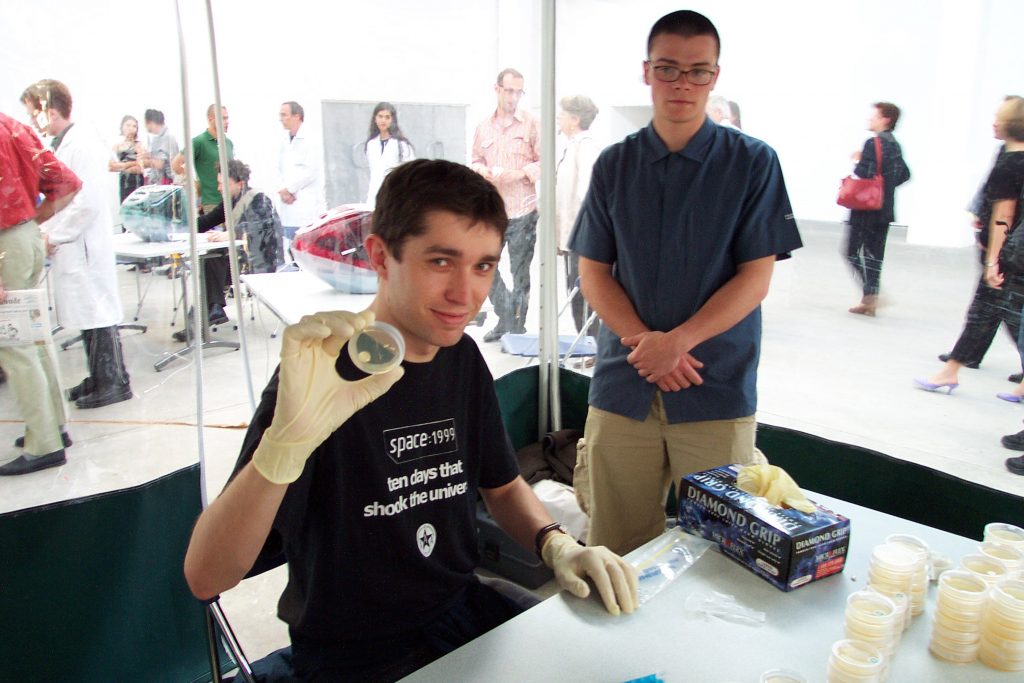
Le Magasin, Centre National d’Art Contemporain, Grenoble, 2001 Viewer/participant holds a completed sample of recombinant bacteria—a job well done.
The paintings of Hieronymous Bosch are excellent visual texts revealing the continuance of the association of fear, monstrosity, and death in the fourth domain. Bosch illustrates the shifting and differing elements between pagan and Christian ideas about the nature of the fourth domain. His paintings are filled with recombinant creatures that mingle with humanity, and he also represents the transformation of humans themselves into recombinant creatures because of their unrepentant transgressions. The variety of creatures representing various depravities in the form of recombination are too numerous to catalogue in this essay. Throughout his work, and most notably in The Garden of Earthly Delights (GED), The Haywain (TH), The Last Judgment (LJ), and The Temptation of St. Anthony (TSA), viewers get a smorgasbord of possible recombinations. The human form is combined with birds (TSA and LJ), with fish (TW), with rats (GED), and with plants (TSA)-all of which are grotesque and frightening to behold.
Bosch also populates his landscapes with human transformations. For example, the berry-head (middle panel, bottom-center-right) in GED represents voracious carnality as a metamorphic catalyst. The phrase “to pluck fruit,” a common vulgarity at the time for a sexual escapade, becomes the metaphor for the fate of a sinful mingler-the loss of humanity, and a reduction of status in the chain of being to that of a plant.
In addition, Bosch catalogues numerous “unnatural acts” in the form of deviant intimacy between animals and humans. This may be read literally, as it seems quite probable that bestiality was on his list of perversions, but there are additional layers. The bird sodomizing a man with its beak in GED (middle panel, top-center-left) indicates a concern for sodomy itself and the sinfulness of homosexuality in general. The pig in a sexual embrace with a nun in GED (third panel, bottom-left) is a reminder of similar sins, but is also a charge against the decadence of the Church, and its fall from the natural order.
Bosch’s images, much like so many representations of earthly recombinancy that sprang from the medieval imagination, are visions of horror and the monstrous that have considerable currency in the present. The model has not changed-not in Gothic horror of the 19th century, nor in the present flights of horrific fantasy that Hollywood presents. Perhaps Hollywood has increased the intensity of the image by increasingly presenting explicit depictions of the codes of the monstrous, but the codes themselves are quite stable.
Beginning with Gothic tales of Frankenstein, the change that occurs is that the recombinant becomes secularized. The natural order is not part of the intention of God; the delightful and the monstrous are just an emergent part of nature itself. Science as the daedalean intervention can help improve the human relationship with the natural order; however, it must stay within the fairly traditional sphere of human intervention. This means that encroachment upon the fourth domain, the domain of hybridity through recombination, should be off limits. When this boundary is crossed, the monstrous appears, and it is usually to the mortal detriment of the one who conjured it. Traces of both pagan and Christian wisdom continue to appear in the notion that transcendent forces, which will bring doom if disturbed, should be left alone.
David Cronenberg’s remake of The Fly4 demonstrates the power and longevity of the representation of the monstrous as recombinant, its new grounding in the secular, and the persistence of the belief that certain creative boundaries should not be crossed. Here, a scientist hoping to make the greatest breakthrough in transportation history begins to fiddle with ideas of teleportation. An investigation into increasing transport velocity is acceptable, and this is not his transgression. The problem begins when he wants to teleport flesh, rather than limiting himself to inanimate objects. However, his computer is unable to reintegrate living tissue. This is the point where he crosses the boundaries of creation-he programs his computer to be imaginative in the manner in which it reassembles the molecules of the flesh. When a fly is caught in the teleportation chamber with him, rather than reintegrating the two as separate entities, the computer combines them, so they might mingle and improve at the molecular level. At first this synthesis has positive effects, but as time goes on and the less desirable traits of the fly begin to assert themselves, the character Seth Brundle becomes increasingly monstrous, until he can no longer be part of the natural or the social order. The moral, in this case, is that messing with time/space for the purpose of transporting objects is fine, since that is within the confines of human agency, but insinuating oneself into the integration of the flesh is unacceptable, and carries with it its own harsh punishment. No character in the film is afraid of teleportation (in fact, most are thrilled by it); rather, the molecular reconstruction of the flesh is what causes fear and skepticism among them. This concern is later amplified by the fact that Brundle’s transgression affects his reproductive system, ending in the passing of his monstrous becoming (a genomic time bomb that removes the stability of species boundaries) on to another generation. The curse of the fly has a germline effect, and that element provides the narrative for The Fly II.
While this data may only be impressionistic, the countless examples of the interconnection between recombinancy, the monstrous, and the ideology of fear are too numerous to ignore. These inescapable, traditional ideological structures are internalized by individuals within western cultures, and send waves of panic whenever they are made manifest. Hence, capital must contend with the nonrational fears that often accompany biotechnological initiatives that explore recombination in the form of the transgenic.
Fear, Imperialism, and Ideological Dissonance in the Fourth Domain
The idea that contamination through the blending of natural separations leads to the monstrous easily slides out of the biological and into the social. In general terms, this mythic structure is among the primary roots that feed the fear of the other. For the west, the semiotic regulatory system of the monstrous (that which has been contaminated by deviant mixing) blends with rational, pseudo-scientific systems, such as Social Darwinism, to create an ideology of separation. The establishment of this ideology has long served colonial and endocolonial initiatives. From the first western imperialist expeditions onward, civilization has been represented as a purifying category-one that liberates the cultural other from the profane and unclean positions of savagery or barbarism. The process begins with a reinscription of the territory of the other with the signs of civilization-manufacturing, commodities, resource management, and the full host of social relations that accompany these materials and processes, all tied together under the sign of providence or progress. Progress assures that the appearance of this symbolic order is presented as enormously positive and indisputable in its generosity, while the signs of the indigenous regimes are parodied, ridiculed, assimilated, or destroyed. Those who refuse assimilation and/or resist their placement in the newly introduced system of separations tend to be categorized as dysfunctional excess ready for disposal. Whether the traditional model of military intervention, or the newer model of commodity desire linked with global market pressures (the replacement for muskets and battering rams) is used, the result is the same: First and third world separation is maintained, and cultural mingling is structured for the material and social benefit of the “civilized.”
As functional and successful as this form of cultural/economic imperialism may be, the system is still imperfect due to its limitations. First, earthly frontier space is finite, and is about to run out. At present, there is no space that is not under capitalist invasion. All that is really left are zones of contestation (such as in Islamic or Maoist cultures). Second, while the body can be made to reflect the signs of civilization, the flesh itself is not fully rationalized to best approximate the ideal demands of capital in terms of market adaptability and efficiency. Consequently, and in relation to this latter difficulty, capital has since the late 19th century placed a great emphasis on constructing an apparatus that would manufacture flesh in accordance with its needs and values. For the first one hundred years capital made clear what needed to be done, but had no idea how to accomplish the task. The various eugenics movements in the west between 1900 and 1945 were failures due to both theoretical and technical impoverishment. However, this situation has recently changed with the appearance of molecular biology and the increased sophistication of genetics. In addition, the former problem of finite territory has also been temporarily solved. The molecular invasion of the body is the new frontier where untold resources and profits may be appropriated.
Transgenic processes are a key part of this development, but they have also left capital with a major ideological problem to solve, because stable, naturalized categories are in theory and practice becoming fluid. The traditional social pressures regarding what constitutes deviant mixing hold back experimental transgenic research and applications. What makes this problem so complicated is that it cannot be neutralized solely through rational argument, nor through the appearance of seductive technologies (as occurred with information, communications, and transportation technologies). The fear factor, which has been refined over the past two millennia, will not disappear in light of any promissory rhetoric or new technology. In fact, the new technology only seems to intensify the level of fear. The unnatural reproduction of the flesh still tends to be seen as taboo within the human/cultural sphere. Further, when the flesh becomes unnaturally mixed, the fear heightens all the more (for example, consider the fear and legislation generated by the prospect of human cloning). Throughout history, ideology has always exclaimed that such mingling is perverse and will bring about punishment and catastrophe, and this is also the common perception of transgenic practices.
For example, the first everyday-life, public interaction with transgenic forms has arrived in the form of genetically modified (GM) food. Certainly there are many rational arguments about why tampering with the food supply at the molecular level should proceed with tremendous caution, if at all. But this is not the sole source of public caution. People are simply afraid of GM food. All varieties of ungrounded speculations exist, particularly fears about the consequences of pollution. Perhaps these foods may cause illness, or could affect one’s own genes. Anxiety about personal catastrophe following eating (mingling with) these perverse foods permeates public perception. The monstrous will reproduce the monstrous, and every bit of folk wisdom and cultural mythology concurs with this conclusion.
In addition, capital must not only find a way to disrupt this deeply internalized, nonrational belief system, but must also maintain it for other purposes. It must continue to be used to support functional social separations and the imperial apparatus. Developing this kind of double-think is a common occurrence in capital, and generally it is relatively prepared for constructing complementary contradictions. The construction of the metanarrative of nature provides an excellent example. On the one hand, the romantic model of nature associates it with goodness and morality. People should do what is natural, and avoid the unnatural. On the other hand, the Hobbesian model defines nature as a blind, barbarous force that runs on an engine of conflict. The role of civilization is to tame these powerful, random, and violent forces, so they might submit to human need. Obviously there are many more narratives of nature that stand in conflict with one another, but this multiple structure allows the code to be deployed in a tactical manner. The narrative that best fits a situation is the one used, and at times, various combinations can be used simultaneously. For example, the colonial subject represents the conflicted status of nature. On the one hand, this subject/animal must be tamed by civilization through the repession of instinctual activity. On the other hand, the rituals and behaviors of the colonial subject are savage (such as scarification or cannibalism) and are perversions and distortions of nature’s perfection. In spite of this ideological flexibility, capital will have a difficult time managing this current ideological dissonance; it is close to causing a serious legitimation crisis on the level of the scientific apparatus and in terms of the relationship of corporate structure (at least that of biotech companies) with public welfare.
For movements that challenge capital’s hegemony, this moment of cultural confusion offers an exploitable glitch in dominant representation. There is a chance to amplify these legitimation crises and undermine areas of traditional authority. However, activists will have as hard a time as capital at intelligently organizing within a spectacle of fear.
The Activist Paradox, or Whose Work Are We Doing?
For capital, the first step in resolving these active ideological contradictions is to restructure the rhetoric that accompanies biotechnology in general. Instead of using the enlightenment promissory rhetoric of creating a new body through technological extensions (a McLuhanesque model that worked very well in structuring the cyborg body), one that can all too often conjure associations with eugenics and other related bioatrocities, there has been a switch to the promissory rhetoric of Christianity-the public is promised miracle cures, edenesque abundance, immortality, and a new universalism. Hence the abundant use of biblical metaphors when describing biological advancements (for example, the trope that the human genome is “God’s blueprint”). Of these promises, the most significant in regard to the fourth domain is a new universalism. DNA is the common element in all life. The lateral transfer of it, even through artificial means, is only a way for the natural constellations to share the bounty of life. On the other hand, this universal characteristic (the new soul) is also one that produces complexity and difference. Transgenics is only going to expand the field of possibilities for life and culture. This method of naturalizing transgenic manufacture should have the effect of reducing the levels of anxiety in the minds of those who have internalized the spectacle of fear associated with the fourth domain. In other words, the fear factor can be regulated and directed in a more precise manner, and remain particular to colonial and endocolonial separations.
To some degree, resistant coalitions and cells concerned with the current applications of biological research and with the corporate attitude of “profits first, risk assessment later” must calm public fears as well. Biotechnological research is a very broad field, much of which could be useful or does not seem to be very dangerous. The most problematic areas in the field (and these are usually social and economic policies about managing biotechnical application, rather than the technology itself) must be identified, and resistant efforts focused upon them. Unfortunately, fear does not allow individuals to pick and choose particular objects of concern. It causes a blanket dismissal of entire categories. Resistant organization in such emotionally charged situations is difficult at best. This leaves cultural and political activists with a two-point mission: First, to neutralize the fear factor, and second, to produce an informed public discourse extracted from a specialized area of knowledge. To accomplish this task, the mythic past and the sci-fi future have to separated from the reality of current research initiatives; utopian rhetoric must be exposed for the propaganda that it is; and people must be taught to be informed amateurs and armed with basic skills in risk assessment. However, the process of meeting these goals is begging for recuperation by dominant culture. The risk of doing its work is what makes the development of this type of pedagogy and subversive representation a roll of the dice. Unfortunately, there is not really any choice. Without fear of the consequences, the US is moving at top velocity to corner this new colonial market/territory. Since biotechnology in general and transgenics in particular is central to profit expansion on a global level, even the most cautious of capital-saturated cultures must move quickly into this territory if they do not want to be locked out of this new economic opportunity.
During this period of molecular invasion, the fourth domain will be transformed more than it has been throughout all the previous periods of history combined. Transformative times are the most productive moments for subversive political and social change (which is a double-edged sword). The construction and manipulations of representation can have a profound impact on discourse generated by nonspecialists, and in turn, affect policy construction in both its process and product, but only if resistant representation is produced from a critical position with the interests of the general public in mind.
**************************
Notes
1. CAE would like to acknowledge the important contribution of Dr. Mustafa Ünlü of the Mellon Institute to the development of this section.
2. This system was suggested in 1977 by C. R. Woese and G. E. Fox after their recognition of archaebacteria as a distinct form of life. For an excellent summation of new trends in classification systems, see, Protein Phylogenies and Signature Sequences: A Reappraisal of Evolutionary Relationships among Archaebacteria, Eubacteria, and Eukaryotes. Microbiology and Molecular Biology Reviews. Dec. 1998, p. 1435-1491.
3. In biological terms, the idea of a fourth domain would be suspect because only small portions of genomes are being moved across domain lines or even between species, and only under tightly controlled, limited conditions. It is unlikely that profound molecular differences would occur at this developmental stage of genetic engineering. Further, some scientists suggest that eukaryotes are naturally transgenic, because molecular study has revealed laterally transferred bacterial traits. “Hundreds of human genes appear likely to have resulted from horizontal transfer from bacteria at some point in the vertebrate lineage.” For additional information see, Lander, et al. Initial Sequencing and Analysis of the Human Genome. Nature. 2001 Feb 15; 409(6822): 860-921.
4. The Fly is a remarkable film in terms of its continuous cultural resonance with the cinema-going public in a time so consumed by developments in biology. It was first made in 1958, and spawned two sequels. It was remade in 1986. The remake was followed by another sequel, making five Fly films in all.
